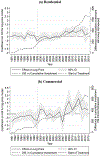Does Large-Scale Neighborhood Reinvestment Work? Effects of Public-Private Real Estate Investment on Local Sales Prices, Rental Prices, and Crime Rates
- PMID: 33013148
- PMCID: PMC7531196
- DOI: 10.1080/10511482.2019.1655468
Does Large-Scale Neighborhood Reinvestment Work? Effects of Public-Private Real Estate Investment on Local Sales Prices, Rental Prices, and Crime Rates
Abstract
During the 1990s, the U.S. Department of Housing and Urban Development awarded more than $6 billion in competitive grants called HOPE VI to spur neighborhood redevelopment. We add to HOPE VI research by examining the impacts of a large set of public-private real estate investments, including HOPE VI, made over a 16-year period in a distressed Pittsburgh neighborhood called the Hill District. Specifically, we estimate the effects of the $468 million additional public-private investments that Hill District received compared to a demographically similar neighborhood on sale prices, rental prices, and crime. We find large and statistically significant impacts of the public-private investments on residential sales prices, commercial sales prices, and on rental prices, but only a marginally significant yet meaningful decline in non-violent arrests. For each additional $10 million of public-private investment, we find a 0.95 percent increase in residential sales prices, 2.7 percent increase in commercial sales prices, and 0.55 percent increase in rental prices. Because there was an accumulated difference over 16 years of $468 million in the amount of public-private investment across the two neighborhoods we examine, these percentage increases amount to large changes in real estate prices over that time. Commercial real estate investors and homeowners benefited the most, followed by residential landlords. Our analyses imply cities should anticipate the potential impacts of major neighborhood investment on low-income households, especially unsubsidized renters that most directly experience the brunt of rising rents.
Keywords: HOPE VI; community development; public housing; real estate.
Conflict of interest statement
Disclosure Statement No potential conflict of interest was reported by the authors.
Figures





Similar articles
-
How much choice is there in housing choice vouchers? Neighborhood risk and free market rental housing accessibility for active drug users in Hartford, Connecticut.Subst Abuse Treat Prev Policy. 2009 Apr 15;4:5. doi: 10.1186/1747-597X-4-5. Subst Abuse Treat Prev Policy. 2009. PMID: 19368713 Free PMC article.
-
Living in public rental housing is healthier than private rental housing a 9-year cohort study from Japan Gerontological Evaluation Study.Sci Rep. 2024 Mar 30;14(1):7547. doi: 10.1038/s41598-024-58244-y. Sci Rep. 2024. PMID: 38555321 Free PMC article.
-
Separating the consumption and investment demands for housing: Evidence from urban China.Heliyon. 2023 Oct 11;9(10):e20683. doi: 10.1016/j.heliyon.2023.e20683. eCollection 2023 Oct. Heliyon. 2023. PMID: 37916106 Free PMC article.
-
The impact of housing prices on residents' health: a systematic review.BMC Public Health. 2024 Apr 1;24(1):931. doi: 10.1186/s12889-024-18360-w. BMC Public Health. 2024. PMID: 38561729 Free PMC article.
-
How much do the public sector and the private sector contribute to biopharmaceutical R&D?Drug Discov Today. 2022 Apr;27(4):939-945. doi: 10.1016/j.drudis.2021.11.027. Epub 2021 Dec 1. Drug Discov Today. 2022. PMID: 34863932 Review.
Cited by
-
Improvements in Neighborhood Socioeconomic Conditions May Improve Resident Diet.Am J Epidemiol. 2021 May 4;190(5):798-806. doi: 10.1093/aje/kwaa220. Am J Epidemiol. 2021. PMID: 33047782 Free PMC article.
-
Does investing in low-income urban neighborhoods improve sleep?Sleep. 2021 Jun 11;44(6):zsaa292. doi: 10.1093/sleep/zsaa292. Sleep. 2021. PMID: 33417708 Free PMC article.
-
Mixed Effects of Neighborhood Revitalization on Residents' Cardiometabolic Health.Am J Prev Med. 2021 Nov;61(5):683-691. doi: 10.1016/j.amepre.2021.04.023. Epub 2021 Jul 3. Am J Prev Med. 2021. PMID: 34226093 Free PMC article.
-
Design of the think PHRESH longitudinal cohort study: Neighborhood disadvantage, cognitive aging, and alzheimer's disease risk in disinvested, black neighborhoods.BMC Public Health. 2023 Apr 3;23(1):636. doi: 10.1186/s12889-023-15381-9. BMC Public Health. 2023. PMID: 37013498 Free PMC article.
-
Revisiting revitalization: exploring how structural determinants moderate pathways between neighborhood change and health.Int J Equity Health. 2022 Nov 18;21(1):165. doi: 10.1186/s12939-022-01771-9. Int J Equity Health. 2022. PMID: 36401246 Free PMC article.
References
-
- Bair E, & Fitzgerald JM (2005). Hedonic estimation and policy significance of the impact of HOPE VI on neighborhood property values. Review of Policy Research, 22(6), 771–786.
-
- Brophy Paul C., and Smith Rhonda N.. 1997. “Mixed-Income Housing: Factors for Success,” Cityscape 3 (2): 3–31.
-
- Brown LN (2009). HOPE VI: An analysis to determine the HOPE VI program’s influence on home sales. Community Development, 40(1), 54–63.
-
- Castells N (2010). HOPE VI Neighborhood Spillover Effects in Baltimore. Cityscape, 12(1), 65–98. Retrieved from http://www.jstor.org/stable/20868733
-
- Chaskin Robert J., and Joseph Mark L.. 2015. Integrating the Inner City: The Promise and Perils of Mixed-Income Public Housing Transformation. Chicago: University of Chicago Press.
Grants and funding
LinkOut - more resources
Full Text Sources
